Chapter 4. Society and Modern Life
4.1. Types of Societies
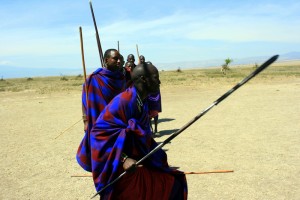
Haida, Maasai, modern Canadians — each is a society. But what does this mean? Exactly what is a society? In sociological terms, a society refers to a group of people who interact within a definable territory and share the same culture. In practical, everyday terms, societies consist of various types of institutional constraint and coordination exercised over our choices and actions. The type of society we live in determines the nature of these types of constraint and coordination. The nature of our social institutions, the type of work we do, the way we think about ourselves, and the structures of power and social inequality that order our life chances are all products of the type of society we live in, and thus vary globally and historically.
The founder of sociology, August Comte (1798–1857), provided the first sociological theory of the evolution of human societies. His best known sociological theory was the law of three stages, which held that all human societies and all forms of human knowledge evolve through three distinct stages from primitive to advanced: the theological, the metaphysical, and the positive. The key variable in defining these stages was the way a people conceptualized causation or how they understood their place in the world.
In the theological stage, humans explain causes in terms of the will of anthropocentric gods (i.e., the gods cause things to happen). In the metaphysical stage, humans explain causes in terms of abstract, “speculative” ideas like nature, natural rights, social contracts, or “self-evident” truths (human nature causes society to take specific forms). This was the basis of Comte’s critique of the Enlightenment philosophers, whose ideas about natural rights and freedoms had led to the French Revolution, but also, in his opinion, to the chaos of its aftermath. In his view, the “negative” or metaphysical knowledge of the philosophers was based on dogmatic ideas that could not be proven empirically, nor reconciled when they were in contradiction. This lead to inevitable conflict and moral anarchy. Finally, in the positive stage, humans explain causes in terms of positivist, scientific observations and laws. That is, law-like relationships between empirically observable variables predict empirically observable outcomes (e.g., if this, then that). Comte believed this would be the final stage of human social evolution, because positivist science could empirically determine how society should be best organized. Science could reconcile the division between political factions of order and progress by eliminating the basis for moral and intellectual anarchy. The application of positive philosophy would lead to the unification of society and of the sciences (Comte, 1830/1975).
Karl Marx offered an alternate model for understanding the evolution of types of society. Marx argued that the evolution of societies from primitive to advanced was not a product of the way people thought, as Comte proposed, but a product of the power struggles in each epoch between different social classes over control of property. The key variable in his analysis was the different modes of production or “material bases” that characterized different forms of society: from hunting and gathering, to agriculture, to industrial production. This historical materialist approach to understanding society explains both social change and the development of human ideas in terms of underlying changes in the mode of production. In other words, the type of society and its level of economic and technical development is determined principally by how a people produces the material goods needed to meet its needs. A society’s world view, including the concepts of causality described by Comte, followed from the way of thinking involved in the society’s mode of production.
On this basis, Marx categorized the historical types of society into primitive communism, agrarian/slave societies, feudalism, and capitalism. Primitive communists, for example, are hunter gatherers like the Haida, whose social institutions and world view develop in sync with their hunting and gathering relationship to the environment and its resources. They are defined by their hunter-gatherer mode of production, in which the necessities of life are shared equally or distributed through potlatch.
Marx went on to argue that the historical transformations from one type of society to the next are generated by the society’s capacity to generate economic surpluses, and the conflicts and tensions that develop when one class monopolizes economic power or property: land owners over agricultural workers, slave owners over slaves, feudal lords over serfs, or capitalists over labourers. These class dynamics are inherently unstable and eventually lead to revolutionary transformations from one mode of production to the next.
To simplify Comte’s and Marx’s schemas, we might examine how different types of society are structured around their relationship to nature. Sociologist Gerhard Lenski (1924–2015) defined societies in terms of their technological sophistication. With each advance in technology, the relationship between humans and nature is altered. Societies with rudimentary technology are at the mercy of the fluctuations of their environment, while societies with industrial technology have more control over their environment, and thus develop different cultural and social features. On the other hand, societies with rudimentary technology have relatively little impact on their environment, while industrial societies transform it radically. The changes in the relationship between humans and their environment exceed the differences in technology to encompass all aspects of social life, including its mental life (Comte) and material life (Marx). Distinctions based on the changing nature of this relationship enable sociologists to describe societies along a spectrum: from the foraging societies that characterized the first 300,000 years of homo sapiens existence to the contemporary postnatural, anthropocene societies in which human activity has had a substantial impact on the global ecosystem.
Preindustrial Societies
Before the Industrial Revolution (1760–1840) and widespread use of machines, societies were small, rural, and dependent largely on local resources. Economic production was limited to the amount of labour a human being could provide, and there were few specialized occupations. Production was (mostly) for immediate consumption, although evidence of trade between groups also dates back to the earliest archaeological records. The very first occupation was that of hunter-gatherer.
Hunter-Gatherer Societies
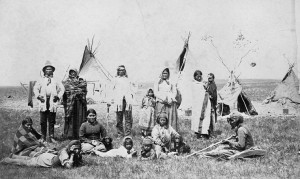
Of the various types of preindustrial societies, Hunter-gatherer societies demonstrate the strongest dependence on the environment. As the basic structure of all human society until about 10,000–12,000 years ago, these groups were based around kinship or tribal affiliations. Hunter-gatherers relied on their surroundings for survival — they hunted wild animals and foraged for uncultivated plants for food. They survived on what nature provided and immediately consumed what they obtained — they produced no surpluses. When resources became scarce, the group moved to a new area to find sustenance, meaning they were nomadic. The plains Indians of North America moved frequently to follow their main source of food. Some groups, like the Haida, lived off abundant, non-depleting resources, like fish, which enabled them to establish permanent villages where they could dwell for long periods of the year before dispersing to summer camps. (See “Making Connections: Big Picture, People of the Far Northwest” below).
Most of the caloric intake of hunters and gatherers came from foraging for edible plants, fruits, nuts, berries, and roots. The largely meat-based diet of the Inuit is a notable exception. Richard Lee (1978) estimated that approximately 65% of the hunter-gatherer diet came from plant sources, which had implications for the gender egalitarianism of these societies. With the earliest economic division of labour being between male hunters and women gatherers, the fact that women accounted for the largest portion of the food consumed by the community ensured the importance of their status within the group. On the other hand, early reports of missionaries among the Algonquins of the north shore of Lake Superior observed women with their noses cut off and small parts of their scalp removed as punishment for adultery, suggesting that (at least among some groups) female subordination was common. Male Algonquins often had seven or eight wives (Kenton, 1954).
As a result of their unique relationship and dependence on the environment for sustenance, the ideal type or model that characterized hunter-gatherer societies includes several common features (Diamond, 1974):
- The distribution of economic surplus is organized on a communalistic, shared basis, in which there is little private property, work is cooperative, and gift giving is extensive. The use of resources was governed by the practice of usufruct, the distribution of resources according to need (Bookchin, 1982).
- Power is dispersed, either shared equally within the community, or shifting between individual members based on individual skills and talents.
- Social control over members of society is exercised through shared customs and sentiment, rather than through the development of formal law or institutions of law enforcement.
- Society is organized on the basis of kinship and kinship ties, so there are few, if any, social functions or activities separate from family life.
- There is little separation between the spheres of intimate, private life and public life. Everything is a matter of collective concern.
- The life of the community is all “personal” and emotionally charged. There is little division of labour so there is no social isolation.
- Art, story telling, ethics, religious ritual and spirituality are all fused together in daily life and experience. They provide a common means of expressing imagination, inspiration, anxiety, need, and purpose.
One interesting aspect of hunter-gatherer societies that runs counter to modern prejudices about “primitive” society, is how they developed mechanisms to prevent their evolution into more “advanced” sedentary, agricultural types of society. For example, in the “headman” structure, the authority of the headman or “titular chief” rests entirely on the ongoing support and confidence of community members, rather than permanent institutional structures. This is a mechanism that actively wards off the formation of permanent, institutionalized power (Clastres, 1987). The headman’s main role is as a diplomatic peacemaker and dispute settler, and he held sway only so long as he maintained the confidence of the tribe. Beyond a headman’s personal prestige, fairness in judgement and verbal ability, there was no social apparatus to enable a permanent institutional power or force to emerge.
Similarly, the Pacific Northwest peoples’ practice of the potlatch, in which goods, food, and other material wealth were regularly given away to neighbouring bands, provided a means of redistributing wealth and preventing permanent inequality from developing. Evidence also shows that even when hunter-gatherers lived in close proximity with agriculturalists they were not motivated to adopt the agricultural mode of production, because the diet of early agricultural societies was significantly poorer in nutrition (Stavrianos, 1990; Diamond, 1999). Recent evidence from archaeological sites in the British Isles suggests, for example, that early British hunter-gatherers traded for wheat with continental agriculturalists 2,000 years before agricultural economies were adopted in ancient Britain (Smith et al., 2015; Larson, 2015). They had close contact with agriculturalists, but were not inclined to adopt their sedentary societal forms, presumably because there was nothing appealing about them.
These societies were common until several hundred years ago, but today only a few hundred remain, such as the Indigenous Australian tribes sometimes referred to as “Aborigines,” or the Bambuti, a group of pygmy hunter-gatherers residing in the Democratic Republic of Congo. Still, in 2014, members of the Amazonian Mashco-Piro clan emerged out of their voluntary isolation at the border of Peru and Brasil to make “first contact” with the Brazilian government’s Indigenous people’s authority (Funai) to seek protection from suspected drug-traffickers (Collins, 2014). Hunter-gatherer groups largely disappeared under the impact of colonization and European diseases, but it is estimated that another 75 uncontacted tribes still inhabit the Amazonian rainforest.
Making Connections: Big Picture
People of the Far Northwest
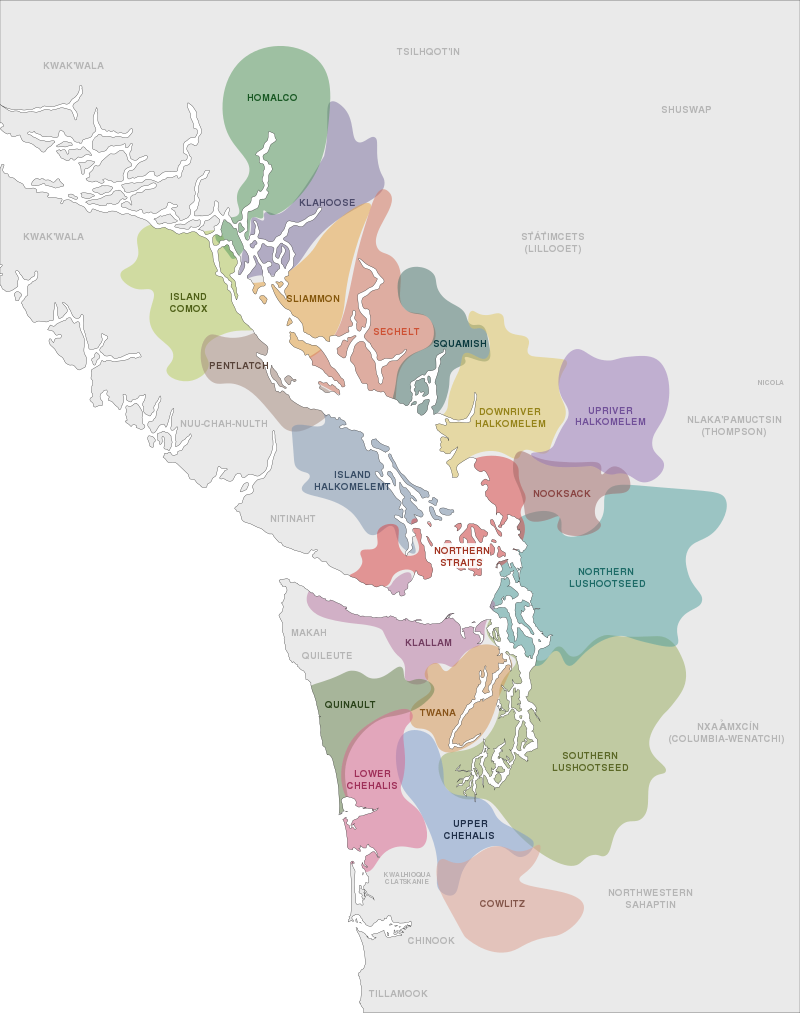
The Pacific Northwest region was utterly separate from the plains and other cultural zones. Its peoples were many and they shared several cultural features that were unique to the region.
By the 1400s there were at least five distinct language groups on the West Coast, including Tlingit, Haida, Tsimshian, Wakashan, and Salishan, all of which divide into many more dialects. However, these differences (and there are many others) are overshadowed by cultural similarities across the region. An abundance of food from the sea meant that coastal populations enjoyed comparatively high fertility rates and life expectancy. Population densities were, as a consequence, among the highest in the Americas.
The people of the Pacific Northwest do not share the agricultural traditions that existed east of the Rockies, nor did they influence Plains and other cultures. There was, however, a long and important relationship of trade and culture between the coastal and interior peoples. In some respects it is appropriate to consider the mainland cultures as inlet-and-river societies. The Salish-speaking peoples of the Straight of Georgia (Salish Sea) share many features with the Interior Salish (Okanagan, Secwepemc, Nlaka’pamux, Stl’atl’imx), though they are not as closely bound as the peoples of the Skeena and Stikine Valleys (which include the Tsimshian, the Gitxsan, and the Nisga’a). Running north of the Interior Salish nations through the Cariboo Plateau, and flanked on the west by the Coast Mountain Range, are societies associated with the Athabascan language group. Some of these peoples took on cultural habits and practices more typically associated with the Pacific Northwest coastal traditions than with the northern Athabascan peoples who cover a swath of territory from Alaska to northern Manitoba. In what is now British Columbia, the Tsilhqot’in, the Dakelh, Wet’suwet’en, and Sekani were part of an expansive, southward-bound population that sent offshoots into the Nicola Valley and deep into the southwest of what is now the United States.
Most coastal and interior groups lived in large, permanent towns in the winter, and these villages reflected local political structures. Society in Pacific Northwest groups was generally highly stratified and included, in many instances, an elite, a commoner class, and a slave class. The Kwakwaka’wakw, whose domain extended in pre-contact times from the northern tip of Vancouver Island south along its east coast to Quadra Island and possibly farther, assembled kin groups (numayms) as part of a system of social rank in which all groups were ranked in relation to others. Additionally, each kin group “owned” names or positions that were also ranked. An individual could hold more than one name; some names were inherited and others were acquired through marriage. In this way, an individual could acquire rank through kin associations, although kin groups themselves had ascribed ranks. Movement in and out of slavery was even possible.
The fact that slavery existed points to the competition that existed between coastal rivals. The Haida, Tsimshian, Haisla, Nuxalk, Heiltsuk, Wuikinuxv (Oowekeeno), Kwakwaka’wakw, Pentlatch/K’ómoks, and Nuu-chah-nulth regularly raided one another and their Stó:lō neighbours. Many winter towns were in some way fortified, and indeed, small stone defensive sniper blinds can still be discerned in the Fraser Canyon. The large number of oral traditions that arise from this era regularly reference conflict and the severe loss of personnel. Natural disasters are also part of the oral tradition: they tell of massive and apocalyptic floods as well as volcanic explosions and other seismic (and tidal) events that had tremendous impacts on local populations.
The practice of potlatch (a public feast held to mark important community events, deaths, ascensions, etc.) is a further commonality. It involved giving away property and thus redistributing wealth as a means for the host to maintain, reinforce, and even advance through the complex hierarchical structure. In receiving property at a potlatch, an attendee was committing to act as a witness to the legitimacy of the event being celebrated. The size of potlatching varied radically and would evolve along new lines in the post-contact period, but the outlines and protocols of this cultural trademark were well-elaborated centuries before the contact moment. Potlatching was universal among the coastal peoples and could also be found among more inland, upriver societies as well.
Horticulture — the domestication of some plants — was another important source of food. West Coast peoples and the nations of the Columbia Plateau (which covers much of southern inland British Columbia), like many eastern groups, applied controlled burning to eliminate underbrush and open up landscape to berry patches and meadows of camas plants that were gathered for their potato-like roots. This required somewhat less labour than farming (although harvesting root plants is never light work), and it functioned within a strategy of seasonal camps. Communities moved from one food crop location to another for preparation and then, later, harvest. A great deal of the land seized upon by early European settlers in the Pacific Northwest included these berry patches and meadows. These were attractive sites because they were cleared of huge trees and consisted of mostly open and well-drained pasture. Europeans would see these spaces as pastoral, natural, and available, rather than anthropogenic (human-made) landscapes — the product of centuries of horticultural experimentation.
“People of the Far Northwest” excerpted from John Belshaw, 2015, Canadian History: Pre-Confederation, (Vancouver: BCCampus). Used under Creative Commons Attribution 4.0 International Licence.
Horticultural and Pastoral Societies
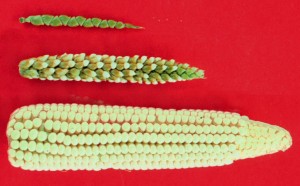
Around 10,200 BCE, another type of society developed in ancient Anatolia, (now part of Turkey), based on the newly developed capacity for people to grow and cultivate plants. Previously, the depletion of a region’s crops or water supply forced hunter-gatherer societies to relocate in search of food sources. Horticultural societies formed in areas where rainfall and other conditions provided fertile soils to grow stable crops with simple hand tools. Their increasing degree of control over nature decreased their dependence on shifting environmental conditions for survival. They no longer had to abandon their location to follow resources and found permanent settlements. The new horticultural technology created more stability and dependability, produced more material goods, and provided the basis for the first revolution in human survival: the neolithic revolution.
Changing conditions and adaptations also led some societies to rely on the domestication of animals where circumstances permitted. Roughly 8,000 BCE, human societies began to recognize their ability to tame and breed animals. Pastoral societies rely on the domestication of animals as a resource for survival. Unlike earlier hunter-gatherers who depended entirely on existing resources to stay alive, pastoral groups were able to breed livestock for food, clothing, and transportation, creating a surplus of goods. Herding, or pastoral, societies remained nomadic because they were forced to follow their animals to fresh feeding grounds.
With the emergence of horticultural and pastoral societies during the neolithic revolution, stable agricultural surpluses began to be generated, population densities increased, specialized occupations developed, and societies commenced sustained trading with other local groups. Feuding and warfare also grew with the accumulation of wealth. One of the key inventions of the neolithic revolution therefore was structured social inequality: the development of a class structure based on the appropriation of surpluses. A social class can be defined as a group that has a distinct relationship to the means of production. In neolithic societies, based on horticulture or animal husbandry as their means of production, control of land or livestock became the first form of private property that enabled one relatively small group to take the surpluses, while another much larger group produced them. For the first time in history, societies were divided between producing classes and owning classes. Moreover, as control of land was the source of power in neolithic societies, ways of organizing and defending it became a more central preoccupation. The development of permanent administrative and military structures, taxation, as well as the formation of specialized priestly classes to spiritually unite society originated on the basis of the horticultural and pastoral relationship to nature.
Agricultural Societies
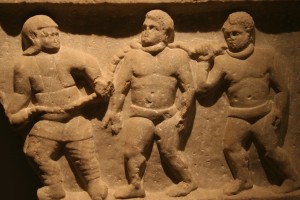
While pastoral and horticultural societies used small, temporary tools, such as digging sticks or hoes, agricultural societies relied on permanent tools for survival. Around 3,000 BCE, an explosion of new technology known as the agricultural revolution made farming possible — and profitable. Farmers learned to rotate the types of crops grown on their fields and reuse waste products, such as fertilizer, which led to better harvests and bigger surpluses of food. New tools for digging and harvesting were made of metal, making them more effective and longer lasting. Human settlements grew into towns and cities, and particularly bountiful regions became centres of trade and commerce.
This era in which some classes of people had the time and comfort to engage in more contemplative and thoughtful activities, such as music, poetry, and philosophy, became referred to as the “dawn of civilization” by some because of the development of leisure and arts. Craftspeople were able to support themselves through the production of creative, decorative, or thought-provoking aesthetic objects and writings.
As agricultural techniques made the production of surpluses possible, social classes and power structures became further entrenched. Kinship ties became secondary to other forms of social allegiance and power. Those with the power to appropriate the surpluses were able to dominate society on a wider scale than ever before. Classes of nobility and religious elites developed. As cities expanded, ownership and protection of resources became an ever-pressing concern, and the militarization of society became more prominent. Difference in social standing between men and women, already initiated in neolithic societies, became more pronounced and institutionalized. Slavery — the ownership and control of humans as property — was also institutionalized as a large scale source of labour. In the agricultural empires of Greece and Rome, slavery was the dominant form of class exploitation. However, as slaves were largely acquired through military acquisition, ancient slavery as an institution was inherently unstable and inefficient.
Making Connections: Sociological Concepts
The Dialectic of Culture, the Monuments of Easter Island and the Cult of Progress
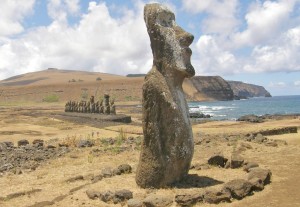
The mystery of the monuments of moai on Easter Island speaks to a key puzzle in the analysis of society and societal change. This mystery has to do with the way that cultural attitudes and beliefs can become rigid and inflexible, sometimes to the degree that they become independent of the material reality they are intended to interpret or give meaning to. Cultural beliefs can take on a life of their own, regardless of whether they have relevance to the survival of a people. The idea of a dialectic of culture refers to the way in which the creation of culture — beliefs, practices, ways of life, technologies, and material artifacts, etc. — is both constrained by environmental limits, and is a means to go beyond these natural limits, to adapt and modify the environment to suit human purposes and needs. This dialectic provides a model for understanding how societies evolve and change, but also reveals the precarious nature of the human/environment relationship.
The anthropologist Ronald Wright (2004) described this phenomenon with regard to the history of the Indigenous people of Easter Island in the South Pacific. The archaeological record shows that Easter Island, or Rapa Nui, once had a lush, richly soiled, and densely treed ecosystem that sustained a population of approximately 10,000 people. However, by the time the Dutch arrived in the early 18th century, the ecosystem of the island was barren, and only 2,000 poorly nourished inhabitants lived there. At the same time, approximately 1,000 massive, 30-foot high monuments, or “moai,” the height of 3-story buildings, were there — one for every 10 inhabitants at the height of the island’s population. The origins of the moai struck European observers as mysterious, because the means of their construction had long vanished. Commentators as late as the 1970s claimed these must have been the work of some vanished ancient civilization, or even visitors from outer space (e.g., von Daniken, 1969).
However, as archeologists discovered, the monuments were erected through concerted human labour to honour the ancestors of rival island clans when the islands were more populated and forested. As the rivalry between clans became more intense around the time of the European Middle Ages, the stone images became increasingly extravagant. Each generation built larger and larger moai by using up valuable resources, especially timber. By 1400, the island was treeless. As Wright (2004) puts it, the compulsion of the statue cults to build more and larger moai to honour the ancestors was an “ideological pathology,” a fixed cultural idea that so defied practical sense that it undermined the ability of a people to survive.
Wright makes the analogy between the statue cults of Easter Island and the contemporary North American “cult of progress” in which an increasing exploitation of resources and accumulation of wealth are valued in themselves. As a modern version of ideological pathology, the cult of progress has no regard for social and environmental sustainability. He cites Bahn and Flenley:
[The islanders] carried out for us the experiment of permitting unrestricted population growth, profligate use of resources, destruction of the environment, and boundless confidence in their religion to take care of the future. The result was an ecological disaster leading to a population crash. Do we have to repeat the experiment on a grand scale? Is the human personality always the same as that of the person who felled the last tree? (Wright, 2004, p. 63)
To understand this dynamic, it is important to attend to the dialectic of culture. As we saw in Chapter 3. Culture, culture is the means a society uses to make sense of the world. It responds to changes in the mode of production or economy of a society. As new types of production are created, the relationship to the world is modified, and new cultural understandings emerge. People begin to see the world in a different way because they are interacting with it in a different way. These understandings are of course influenced by the corresponding relations of power in society, which determine whose perspectives on the world become “truths” and whose do not.
In this dialectical model, it is important to point out that changes in the mode of production do not determine or cause cultural beliefs in some sort of mechanical relationship, just as the invention of the piano did not cause Mozart’s piano concertos to be written. As Marx puts it:
Mankind always sets itself only such tasks as it can solve; since, looking at the matter more closely, it will always be found that the task itself arises only when the material conditions for its solution already exist or are at least in the process of formation” (Marx, 1977/1859).
To this, we might add that the “tasks” or cultural possibilities set by the material conditions of a society can be taken up in many different ways, or not at all. On the other hand, as Wright’s examples show, cultural beliefs, practices, and tasks can become rigid and unresponsive to material reality, unhinged from the ability of the environment or the economy to sustain them. Therefore, it is appropriate to view culture as being in a fluid and dialectical relationship with the mode of production. One does not cause the other in a deterministic manner; rather, both provide the limits or parameters within which the other develops. If a culturally driven process exceeds the capacity of material reality to sustain it, the culture is in danger of no longer being viable.
Feudal Societies
In Europe, the 9th century gave rise to feudal societies. Feudal societies were still agriculturally based, but organized according to a strict hierarchical system of power founded on land ownership, military protection, and duties or mutual obligations between the different classes. Feudalism is usually used in a restricted sense by historians to describe the societies of post-Roman Europe, from roughly the 9th to the 15th centuries (the “middle ages”), although these societies bear striking resemblance to the hierarchical, agricultural-based societies of Japan, China, and pre-contact America (e.g., Aztec, Inca) of the same period.
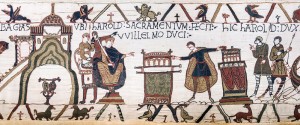
In Europe the class system of feudalism was organized around the parceling out of manors or estates by the aristocracy to vassals and knights in return for their military service. The nobility, known as lords, rewarded knights or vassals by granting them pieces of land. In return for the resources that the land provided, vassals promised to fight for their lords. These individual pieces of land, known as fiefdoms, were cultivated by the lower class of serfs. Serfs were not slaves, in that they were at least nominally free men and women, but they produced agricultural surpluses for lords primarily through forced agricultural service. In return for maintaining and working the land, serfs were guaranteed a place to live and military protection from outside enemies. They were able to produce food and goods for their own consumption on private land allotments, or on common allotments shared by the community. Power in feudal society was handed down through family lines, with serf families serving lords for generations and generations.
In later forms of feudalism, the forced labour of the serfs was gradually replaced by a system of rents and taxation. Serfs worked their own plots of land, but gave their lords a portion of what they produced. Gradually payment in the form of goods and agricultural surplus was replaced by payment in the form of money. This prompted the development of markets in which the exchange of goods through bartering was replaced by the exchange of goods for money. This was the origin of the money economy. In bartering, the buyer and the seller have to need each other’s goods. In a market economy, goods are exchanged into a common medium of value — money — which can then be exchanged for goods of any nature. Markets therefore enabled goods and services to be bought and sold on a much larger scale and in a much more systematic and efficient way. Money also enabled land to be bought and sold instead of handed down through hereditary right. Money could be accumulated and financial debts could be incurred.
Ultimately, the social and economic system of feudalism was surpassed by the rise of capitalism and the technological advances of the industrial era, because money allowed economic transactions to be conceived and conducted in an entirely new way. In particular, the demise of feudalism was initiated by the increasing need to intensify labour and improve productivity, as markets became more competitive and the economy less dependent on agriculture.
Industrial Societies

In the 18th century, Europe experienced a dramatic rise in technological invention, ushering in an era known as the Industrial Revolution. What made this period remarkable was the number of new inventions that influenced people’s daily lives. Within a generation, tasks that had until this point required months of labour became achievable in a matter of days. Before the Industrial Revolution, work was largely person- or animal-based, relying on human workers or horses to power mills and drive pumps. In 1782, James Watt and Matthew Boulton created a steam engine that could do the work of 12 horses by itself.
Steam power began appearing everywhere. Instead of paying artisans to painstakingly spin wool and weave it into cloth, people turned to textile mills that produced fabric quickly at a better price, and often with better quality. Rather than planting and harvesting fields by hand, farmers were able to purchase mechanical seeders and threshing machines that caused agricultural productivity to soar. Products such as paper and glass became available to the average person, and the quality and accessibility of education and health care rise dramatically. Gas lights allowed increased visibility in the dark, and towns and cities developed a nightlife.
One of the results of increased wealth, productivity, and technology was the rise of urban centres. Serfs and peasants, expelled from their ancestral lands, flocked to cities in search of factory jobs, and the populations of cities became increasingly diverse. The new generation became less preoccupied with maintaining family land and traditions, and more focused on survival in the precarious new wage labour market. Some were successful in acquiring wealth and achieving upward mobility for themselves and their family. Others lived in devastating poverty and squalor. The class system of feudalism had been rigid, and resources for all but the highest nobility and clergy were scarce. Under capitalism, social mobility (both upward and downward) became possible.
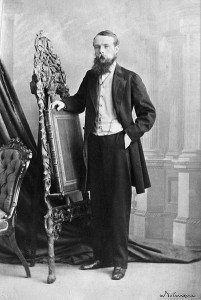
It was during the 18th and 19th centuries of the Industrial Revolution that sociology was born. Life was changing quickly, and the long-established traditions of the agricultural eras did not apply to life in the larger cities. Masses of people moved to new environments, and often faced horrendous conditions of filth, overcrowding, and poverty. As we noted in Chapter 1. An Introduction to Sociology, sociology was born in the 19th century in response to the unprecedented scale of the social problems of modern society.
It was during this time that power moved from the hands of the aristocracy and “old money” to the new class of rising bourgeoisie, who were able to amass fortunes in their lifetimes. In Canada, a new cadre of financiers and industrialists like Donald Smith (1st Baron Strathcona and Mount Royal) and George Stephen (1st Baron Mount Stephen) became the new power players, using their influence in business to control aspects of government. Eventually, concerns about the exploitation of workers led to the formation of labour unions and laws that set mandatory conditions for employees. Although the introduction of new “postindustrial” technologies (like computers) at the end of the 20th century ended the industrial age, much of our social structure and social ideas — such as the nuclear family, left-right political divisions, and time standardization — have a basis in industrial society.
Postindustrial Societies

Information societies, sometimes known as postindustrial or digital societies, are a recent development. Unlike industrial societies that are rooted in the production of material goods (resources, automobiles, chemicals, electrical goods, steel, etc.), information societies are based on the production of information, knowledge, and services. Companies, regions, and countries depend more and more on knowledge, information, and information processing technology as sources of productivity and competitiveness (Castells, 2010).
Lash and Urry (1994) describe this as a shift to the production of ephemeral “signs” as opposed to durable “things.” The products of information societies are abstract and mobile, rather than tangible and stable. Of principle importance are informational products with cognitive content (such as scientific research and development, biotechnologies, financial products, marketing surveillance, software apps and social media platforms), and media, image, and design products with aesthetic content (such as advertising, fashion, pop music, cinema, leisure, and digital streaming). An increasing component of the value of commodities comes from branding and lifestyle marketing, which advertisers and marketers use to attach images and meaning to goods.
Digital technology is the steam engine of information societies, and high tech, e-commerce, and social media companies such as Apple, Microsoft, Facebook (Meta), Google (Alphabet Inc.), and Amazon are its version of railroad and steel manufacturing corporations. The new core of post-industrial society is clustered around financial services (such as banking and insurance), global information and communications services, as well as other services like transportation, airlines, tourism, and leisure. All of these depend in a fundamental way on the revolution in informational and communication technologies.
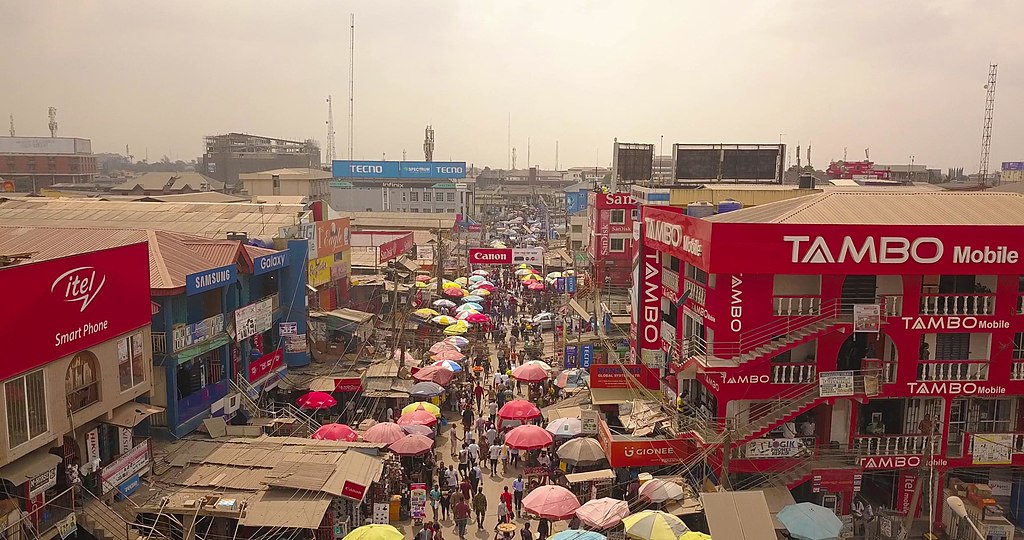
Since the economy of information societies is driven by knowledge and not material goods, power lies with those in control of creating, storing, and distributing information. The core occupations of a postindustrial society are likely to be sellers of informational services — designers, software programmers, or business consultants, for example — instead of producers of goods. Social classes are divided by access to education, since without technical and communication skills, people in an information society lack the means for success. The digital divide refers to the gap between those able to access and make effective use of information technology and those who cannot (Menzies, 1996). In Canada, this disproportionately marginalizes racialized groups, and especially Indigenous communities (Bredin, 2001). The COVID-19 pandemic and shift to accessing work, education, and services from home illustrated stark divides between access to broadband between rural and urban areas. In 2021, 87% of all households in Canada had access to broadband with sufficient bandwidth, but only 46% of rural households had access (CRTC, 2021).
Information and knowledge based societies tend to privilege reflexive forms of subject and subjectivity (Giddens, 1991). The freedom-oriented countercultural movements of the late 1960s and early 1970s, including the civil rights movement, the feminist movement, and the environmental movement, instigated a shift to reflexive subjectivity. Tradition, established social roles, or modern institutions no longer confined people’s self-identity. Rather, people began to take an increasingly critical and reflexive distance with respect to these institutions. Knowledge, self-reflection, and self-awareness provide individuals with the opportunity to disembed themselves from prescribed roles and construct their own identities. In the knowledge economy, work tasks often require the ability to reflect on and recreate work materials, rather than simply follow the structured work patterns of the industrial labour process. Workers must self-reflect and self-monitor their work process independently of direct supervision. Similarly, in information societies, a reflexively individualized public tends to question “what they are told” by authorities, science and expert systems, and increasingly seek to monitor and organize their own individual life-narratives (Lash and Urry, 1994).
Globally, information and communication structures are transforming national economies and societies. For the first time, a truly global society can be said to have emerged. On the basis of information technologies, the dominant economic activities that link societies, such as financial markets, currency exchanges, business services, technological development, and media communication, operate as a single unit in real time on a planetary scale (Castells, 2010). However, the distribution of this economic activity is uneven. Information and communication networks cover the entire globe, connecting valuable production, markets, and workers, but exclude large sections of the global population who are unskilled, unprofitable, and “structurally irrelevant.”
Castells (2010) describes the characteristic form of organization in this global structure as the network enterprise. The network enterprise model links autonomous agents (companies, segments of companies, producers and suppliers, etc.), which are often geographically disperse, and organizes them temporarily for specific projects or tasks. Once the task is completed the network dissolves or reforms to begin a new project. Through the network enterprise, hubs of economic activity or “global cities” like Vancouver, Tokyo, and Hong Kong, or Toronto, San Jose, and Osaka, might be more closely linked to each other than to their surrounding hinterlands. Thus, for Castells (2004), the postindustrial information society is also a network society: “a society whose social structure is made up of networks powered by micro-electronics-based information and communications technologies.”
Postnatural Society: The Anthropocene

Recent scientific and technological developments transform our relationship to nature to such a degree that it is possible to talk about a new postnatural society. Advances in computing, genetics, nano-technology, and quantum mechanics create the conditions for society in which the limits imposed by nature are overcome by technological interventions at the molecular level of life and matter. Donna Haraway (1991) describes the new “cyborg” reality that becomes possible when the capacities of the body and mind are enhanced by various prosthetic devices like artificial organs or body parts. When these artificial prosthetics do not simply replace defective anatomy but improve upon it, one can argue that the conditions of life have become postnatural. In his science fiction novel Holy Fire (1996), Bruce Sterling extrapolates from recent developments in medical knowledge to imagine a future epoch of posthumanity; i.e., a period in which the mortality that defined the human condition for millennia has effectively been eliminated through the technologies of life preservation. Under these conditions, humans transcend the human condition and become posthuman.
Through genetic engineering, scientists have been able to create new life forms since the early 1970s. This research is fueled by the prospect of using genetic technologies to solve problems, like disease and aging, at the level of the DNA molecule that contains the “blueprint” of life. Food crops can be designed that are pest-resistant, drought-resistant, or more productive. These technologies are therefore theoretically capable of solving environmentally imposed restrictions on our collective ability to feed the hungry. Similarly, nanotechnologies, which allow the physical properties of materials to be engineered at the atomic and subatomic level, pose the possibility of an infinitely manipulable universe. The futurologist Ray Kurzweil (2009) suggests that on the basis of nanotechnology “we’ll be able to create just about anything we need in the physical world from information files with very inexpensive input materials.” Others caution that the complexity of risks posed by the introduction of these molecular technologies into the environment makes their use decidedly dangerous and their consequences incalculable. This is a very postnatural society dilemma — one that would not have occurred to people as a realistic problem in the earlier types of society described above.
What are the effects of postnatural technologies on the structure and forms of social life and society? At present, these technologies are extremely capital-intensive to develop, which suggests that they will have implications for social inequality — both within societies and globally. Wealthy nations and wealthy individuals will be the most likely beneficiaries. Moreover, as the development of postnatural technologies do not impact the basic structures of capitalism, for the forseeable future decisions on which avenues of research are to be pursued will be decided solely by private corporations on the basis of profitable returns. Many competing questions concerning the global risks of the technologies and the ethics of their implementation are secondary to the profit motives of the corporations that own the knowledge.
In terms of the emergent life technologies like genetic engineering or micro-biochemical research, Nikolas Rose (2007) suggests that we are already experiencing five distinct lines of social transformation:
- The “molecularization” of our perspective on the human body, or life in general, implies that we now visualize the body and intervene in its processes at the molecular level. We are “no longer constrained by the normativity of a given order.” From growing skin in a petri dish to the repurposing of viruses, the body can be reconstructed in new, as yet unknown forms because of the pliability of life at the molecular level.
- The technologies shift our attention to the optimization of the body’s capacities rather than simply curing illness. It becomes possible to address our risk and susceptibility to future illnesses or aging processes, just as it becomes feasible to enhance the body’s existing capacities (e.g., strength, cognitive ability, beauty, etc.).
- The relationship between bodies and political life changes to create new forms of biological citizenship or biosociality. We increasingly construct our identities according to the specific genetic markers that define us, (e.g., “we are the people with Leber’s Amaurosis”), and on this basis advocate for policy changes, accommodations, resources, and research funding, etc.
- The complexity of the knowledge in this field increasingly forces us to submit ourselves to the authority of a group of new somatic specialists and medical authorities, from neurologists to genetics counselors.
- As the flows of capital investment in biotechnology and biomedicine shift towards the creation of a new “bioeconomy,” the fundamental processes of life are turned into potential sources of profit and “biovalue.”
Some have described the postnatural period that we are currently living in as the Anthropocene. The anthropocene is defined as the geological epoch following the Pleistocene and Holocene in which human activities significantly impact and transform the global ecosystem (Crutzen and Stoermer, 2000). Climate change is the primary example of anthropocenic effect, but it includes a number of other well-known examples, from soil erosion and species extinction to the acidification of the oceans. Of course this impact began at least as early as the 19th century with the effects on the environment caused by the Industrial Revolution. Arguably, however, it is the recently established knowledge and scientific evidence of these effects which constitutes the current era self-consciously as the anthropocene. In the anthropocene we become aware of the global nature of the catastrophic risks that human activities pose to the environment. It is also this knowledge that enables the possibility of institutional, economic, and political change to address these issues. Current developments like the use of cap and trade or carbon pricing to factor in the cost the environmental impact into economic calculations, the shift to “green” technologies like solar and wind power, or even curbside recycling, have both global implications and direct repercussions for the organization of daily life.
Media Attributions
- Figure 4.3 Masai 17 by Abir Anwar, via Flickr, is used under a CC BY 2.0 licence.
- Figure 4.4 Blackfoot Indians (unknown date – before 1923) from Library and Archives Canada, via Wikimedia Commons, is in the public domain.
- Figure 4.5 Distribution of Coast Salish languages in the early 19th century by Noahedits is licenced under CC BY-SA 4.0 via Wikimedia Commons.
- Figure 4.6 Maize-teosinte by John Doebley, via Wikimedia Commons, is used under a CC BY 3.0 licence.
- Figure 4.7 Roman Collared Slaves Marble relief, Smyrna (Izmir, Turkey), AD 200, from the Collection of the Ashmolean Museum in Oxford, England, uploaded by Jun, via Flickr, is used under a CC BY-SA 2.0 licence.
- Figure 4.8 Isla de Pascua – 628 .- by Alberto Beaudroit, via Wikimedia Commons, is used under a CC BY-SA 4.0 licence.
- Figure 4.9 Bayeux Tapestry – Scene 23 , by Myrabella, via Wikipedia (Ukraine), is in the public domain.
- Figure 4.10 Colgate-Palmolive Canada 1919 by Pringle & Booth, Toronto (available from the Toronto Public Library), via Wikimedia Commons, is in the public domain.
- Figure 4.11 George Stephen, 1965 by William Notman, via Wikimedia Commons, is in the public domain. (Image is available from the McCord Museum under the access number I-14179.1)
- Figure 4.12 The Desk by Charlie Styr, via Flickr, is used under a CC BY-NC-ND 2.0 licence.
- Figure 4.13 Handroid City by Nolwennlaureg/ Emo de Medeiros, via Wikimedia Commons, is used under a CC BY-SA 4.0 licence.
- Figure 4.14 Dengue virus infection by Vaccines at Sanofi Pasteur, via Flickr, is used under a CC BY-NC-ND 2.0 licence.

